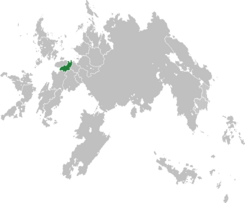Vetonia: Difference between revisions
(Created page with "{{WIP}} {{Infobox country | conventional_long_name = Veton Republic | common_name = Vetonia | native_name = ''Republic vetonien'' <small>(ja)</small><br> ''...") |
mNo edit summary |
||
| Line 21: | Line 21: | ||
| government_type = {{wpl|Federal state|Federal}} {{wpl|Parliamentarism|parliamentary}} {{wpl|Constitutional republic|constitutional republic}} | | government_type = {{wpl|Federal state|Federal}} {{wpl|Parliamentarism|parliamentary}} {{wpl|Constitutional republic|constitutional republic}} | ||
| leader_title1 = [[President of Vetonia|President]] | | leader_title1 = [[President of Vetonia|President]] | ||
| leader_name1 = [[ | | leader_name1 = [[Agate Fromantin]] | ||
| leader_title2 = [[Prime Minister of Vetonia|Prime Minister]] | | leader_title2 = [[Prime Minister of Vetonia|Prime Minister]] | ||
| leader_name2 = [[ | | leader_name2 = [[Pierre Goulard]] | ||
| leader_title3 = [[Chamber of Deputies (Vetonia)|President of the Chamber]] | | leader_title3 = [[Chamber of Deputies (Vetonia)|President of the Chamber]] | ||
| leader_name3 = [[xx]] | | leader_name3 = [[xx]] | ||
Revision as of 09:35, 5 September 2019
This article is incomplete because it is pending further input from participants, or it is a work-in-progress by one author. Please comment on this article's talk page to share your input, comments and questions. Note: To contribute to this article, you may need to seek help from the author(s) of this page. |
Veton Republic | |
|---|---|
Coat of arms
| |
Motto: Homo mensura (Old Aesculian) "Man [is] the measure [of all things]" | |
 | |
| Capital and largest city | Andraid |
| Official languages | None |
| Recognised national languages | Javol Iverdonian |
| Recognised regional languages | Silurian Rodenese Tarbel |
| Ethnic groups (2016) | Javol (45.8%) Iverdognan (22.3%) Silurian (16.2%) Rodenese (7.2%) Tarbel (5.6%) Aesculian (0.9%) Other (2%) |
| Demonym(s) | Vetonian (vetonien) |
| Government | Federal parliamentary constitutional republic |
| Agate Fromantin | |
| Pierre Goulard | |
| xx | |
| xx | |
| Legislature | National Assembly |
| Senate | |
| Chamber of Deputies | |
| Independence from Aesculia | |
• ? | ? |
• Independence declared | 1913 |
| 29 February 1916 | |
| 1920 | |
• Federal reform | 1958 |
| Area | |
• Total | 199,785.2 km2 (77,137.5 sq mi) (?) |
• Water (%) | 5.9 |
| Population | |
• 2016 estimate | 23,681,712 (?) |
• Density | 143.56/km2 (371.8/sq mi) (?) |
| GDP (PPP) | 2018 estimate |
• Total | $1.361 trillion (?) |
• Per capita | $57,484 (?) |
| GDP (nominal) | 2018 estimate |
• Total | $1.315 trillion (?) |
• Per capita | $55,553 (?) |
| Gini (2015) | low · ? |
| HDI (2017) | very high · ? |
| Currency | Vetonian livre (VT) |
| Time zone | UTC? (?) |
• Summer (DST) | UTC? (?) |
| Date format | dd-mm-yyyy |
| Driving side | left |
| Calling code | +05 |
| Internet TLD | .vt |
The Veton Republic (Javol: Republica vetonien, pronounced: [rə'pi.bli.kə və.tu'njen]; Iverdonian: République vétonienne, pronounced: [ʁe.py.blik ve.to.njɛn]), commonly referred to as Vetonia (Javol: Vetoní, pronounced: [vətu'ni]; Iverdonian: Vétonie, pronounced: [ve.to.ni]) is a sovereign state organised as a federal parliamentary constitutional republic in southern Plateia. The country borders Castelana to the west, xx to the east, Aesculia to the north-east and the Lautan Ocean to the south. The country covers an area of approximately 192,286 square kilometres (74,242 square miles) with a mostly temperate, oceanic climate. It has a population of over 23.6 million people. Its capital and largest city is Andraid, with 1.7 million residents; other major cities include ?, ? and ?.
Vetonia is divided into four constituent states (païs in Javol, pays in Iverdonian), Vellavia, Tosandria, Iverdonia and Rodenia. These states are divided by language, Javol-speaking Vellavia and Tosandria, Iverdonian-speaking Iverdonia and Rodenese-speaking Rodenia. There are also significant minorities of !Celtic Silurians in Vellavia and Tosandria, as well as of Tarbel in both Iverdonia and Rodenia.
old history
Vetonian independence from the Aesculian Empire was declared in 1911 by ? and ?, although its independence would not be recognised until the signature of the Treaty of XX that ended the Great Continental War. After independence, a democratic constitution was adopted in 1916 and in 1920, the territory of modern-day Rodenia was annexed following the xx conflict. The period between the 1930s to 1974 was marked by heightened tensions between the country's various ethnic groups fueled by unequal economic development and linguistic differences between communities. Far-reaching reforms enacted in 1958 and implemented during the 1960s mollified ethnic conflict and resulted in the transition of the country to a federal system. Ethnic and territorial tensions have subsued but continue to mark the country's political and social cleavages (pillarisation).
Today, Vetonia is a developed country with a mixed-market economy. It ranks amongst the highest in international indexes of education, health care, quality of life, life expectancy at birth and human development, as well as happiness.
Etymology
The name of 'Vetonia' (Vetoní, Vétonie) is a
